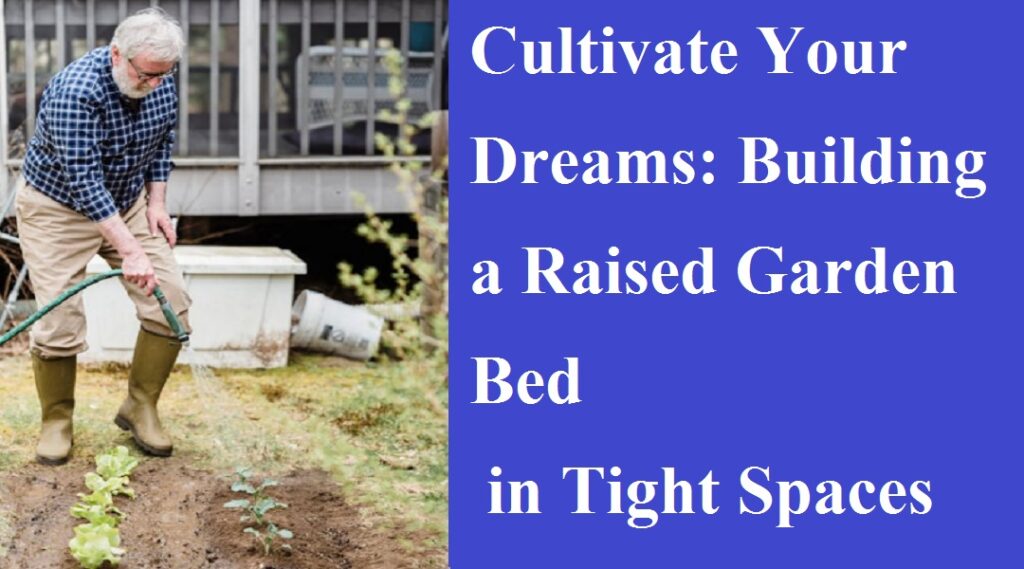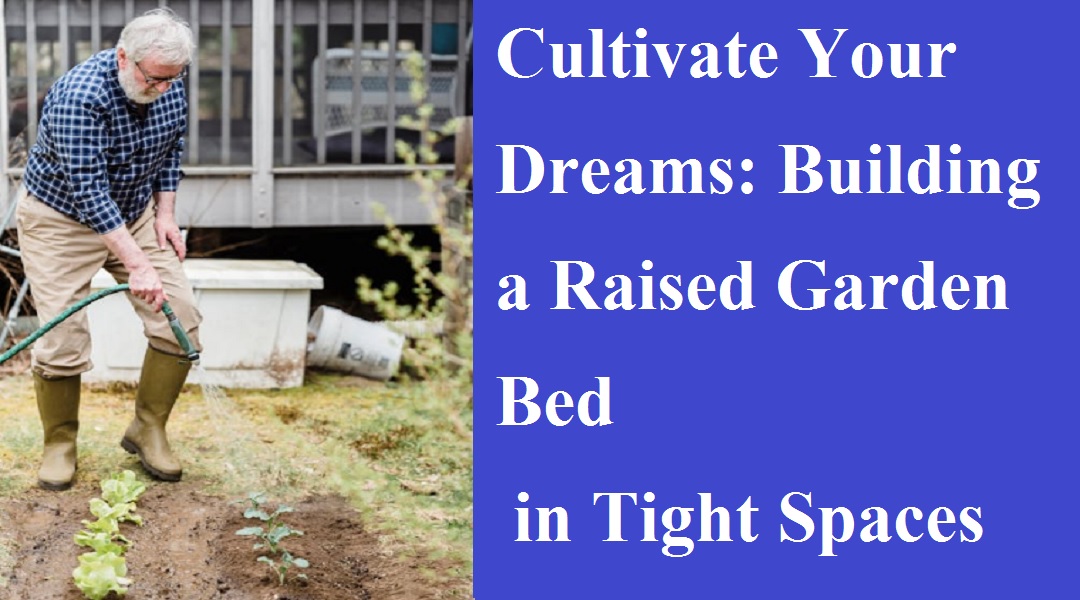
Building a Raised Garden Bed in Tight Spaces : For city dwellers and space-conscious gardeners, the dream of fresh, homegrown produce might seem like a distant utopia. But fret no more! Raised garden beds offer a game-changing solution, transforming even the most limited balconies, patios, or sunny nooks into flourishing mini-farms.
Building a Raised Garden Bed in Tight Spaces
This comprehensive guide empowers beginners with everything they need to know about building a raised garden bed – perfect for those yearning to cultivate their own slice of veggie paradise. We’ll delve into the undeniable benefits, explore a variety of materials, navigate design considerations, and provide a step-by-step construction process, ensuring a successful (and space-saving) gardening adventure.
Why Raised Garden Beds are Ideal for Beginners with Limited Space
Raised garden beds are champions for small-scale gardening. Here’s why they’re a perfect fit for beginners with limited space:
Maximize Your Growing Area:
They allow you to create a defined planting area, optimizing every precious inch of your balcony, patio, or rooftop.
Superior Drainage:
Unlike traditional in-ground gardens, raised beds offer excellent drainage, preventing root rot, especially crucial for beginners who might be unfamiliar with ideal watering practices.
Enhanced Soil Quality:
You have complete control over the soil mix within the raised bed, ensuring it’s rich in nutrients and perfectly suited for your chosen plants.
Reduced Maintenance:
Raised beds significantly reduce weed growth, saving you time and effort on constant weeding.
Ergonomic Design:
Raised beds eliminate the need for excessive bending and kneeling, making gardening more comfortable, especially for those with back problems.
Aesthetic Appeal:
Raised beds add a touch of beauty and structure to your outdoor space, transforming it into a charming urban oasis.
Choosing the Right Materials for Your Raised Garden Bed
The material selection for your raised bed hinges on your budget, desired aesthetics, and the intended lifespan of your creation. Here are some popular options to consider:
Wood:
A classic choice, offering warmth and a natural look. Opt for rot-resistant cedar, redwood, or pressure-treated lumber. Remember, pressure-treated wood requires a waiting period before planting to allow harsh chemicals to dissipate.
Stone or Brick:
Provides a permanent and elegant solution, perfect for creating a timeless and low-maintenance garden feature. However, stone and brick require more construction expertise and can be expensive.
Metal:
Galvanized steel or aluminum offer a modern aesthetic and durability. However, metal heats up quickly in direct sunlight, potentially harming plants. Consider double walls or painting the interior a light color for insulation.
Raised Garden Kits:
Available in various materials and sizes, these kits offer a convenient option with pre-cut pieces and assembly instructions. Perfect for those seeking a hassle-free approach.
Upcycled Materials:
Get creative! Repurpose old wooden pallets, cinder blocks, or even sturdy plastic containers to build your raised bed. Just ensure proper drainage and avoid using materials that could leach harmful chemicals into the soil.
Design Considerations for Space-Saving Raised Garden Beds
Before grabbing your tools, consider these key design factors to optimize your raised bed for both functionality and aesthetics:
Size:
Crucial for maximizing space. A raised bed of 3ft x 6ft is a great starting point for beginners, allowing easy access from all sides. Aim for a height of 12-18 inches, providing comfortable gardening without excessive bending.
Shape:
Rectangular beds are space-efficient. However, L-shaped or U-shaped beds can fit snugly into corners, maximizing even the tightest spaces.
Location:
Choose a sunny spot receiving at least 6-8 hours of direct sunlight daily. Ensure the location is easily accessible for watering, tending, and harvesting. Avoid placing your raised bed near overhanging structures that might cast shade.
Building Your Raised Garden Bed: A Step-by-Step Guide
Now that you’re armed with the knowledge of materials and design, let’s get your hands dirty (in a good way) and build your raised garden bed!
Materials:
- Chosen building material (wood planks, pre-cut kit pieces, etc.)
- Saw (if using uncut lumber)
- Drill
- Screws or nails (appropriate for your chosen material)
- Landscape fabric
- Staple gun
- Optional: Level, hammer, mallet, gloves
Steps:
- Prepare the Site: Clear the chosen area of any debris or vegetation. If necessary, level the ground using a shovel and level.
- Cut Lumber (if using): Cut your lumber to the desired lengths according to your design plan. Ensure all cuts are straight and clean.
- Assemble the Frame (continued): Pre-drill holes at the connecting points to prevent wood splitting during screw insertion. Screw or nail the pieces together to form the frame of your raised bed. Double-check for squareness using a level at the corners.
- Attach Landscape Fabric (Optional): Cut a piece of landscape fabric slightly larger than the base of your raised bed. Lay it over the bottom of the frame. Use a staple gun to secure the fabric to the underside of the frame, ensuring proper drainage by creating small folds or cuts in the fabric where the drainage holes (if any) will be located.
- Create Drainage Holes (if using wood): For optimal drainage, especially when using wood, drill several holes (½ inch diameter) in the bottom of the raised bed frame. Aim for even distribution of holes across the base.
- Positioning Your Raised Bed: Carefully lift and position your completed raised bed in its designated location. Ensure it’s level and stable.
- Filling Your Raised Bed: Here comes the fun part! Fill your raised bed with high-quality potting mix specifically designed for vegetable gardens. Avoid using garden soil directly from the ground, as it might be compacted, lacking in nutrients, or harbor unwanted pests.
- Let it Settle: After filling the raised bed, the soil might settle slightly. Wait a week or two before planting your seeds or seedlings to allow the soil to compact naturally. Top up with additional potting mix if needed.
Planting and Maintaining Your Raised Garden Bed
With your raised bed prepped and filled, it’s time to unleash your inner green thumb! Here are some additional pointers for successful planting and maintaining your urban oasis:
Choose Your Plants Wisely:
Select vegetables, herbs, or flowers that thrive in containers and are suitable for your climate zone. Research their sun and water requirements to ensure optimal growth. Some beginner-friendly options for raised beds include lettuce, spinach, tomatoes, peppers, herbs like basil and mint, and even certain dwarf fruit trees.
Proper Planting:
Follow recommended spacing guidelines for your chosen plants on seed packets or plant labels. Group plants with similar sun and water needs together for efficient watering.
Watering:
Water your raised bed regularly, especially during hot and dry periods. Aim to keep the soil consistently moist but not waterlogged. Feel the soil with your finger to gauge moisture levels. Water deeply when the top inch of soil feels dry.
Feeding:
Throughout the growing season, replenish nutrients in the soil with a balanced organic fertilizer according to the instructions on the product label. Opt for slow-release fertilizers to provide a steady stream of nutrients for your plants.
Weed Control:
Regularly remove weeds that compete with your plants for water and nutrients. Hand-pulling weeds is the most eco-friendly approach.
Harvesting:
The joy of reaping the rewards of your labor! Harvest your vegetables, herbs, or flowers when they are ripe and at their peak flavor.
Raised bed gardening is a journey of learning and experimentation. Don’t get discouraged if you encounter challenges. Observe your plants, adjust your watering and fertilizing routines as needed, and enjoy the process of nurturing your own little piece of veggie paradise!
By following these steps and incorporating the valuable tips, you’ll be well on your way to building and cultivating a thriving raised garden bed, even with limited space. So, grab your tools, unleash your creativity, and get ready to witness the magic of homegrown goodness blossom right outside your door!
- Unleash the Harvest: Fast-Growing Vegetables for California’s Raised Garden Beds
 Fast-Growing Vegetables for California’s Raised Garden Beds : California’s golden sunshine, mild climate, and fertile soil are a gardener’s dream. Elevated planting in raised garden beds takes this advantage to the next level. These controlled environments offer improved drainage, easier pest management, and the perfect canvas for cultivating a fast and furious vegetable bounty. Fast-Growing… Read more: Unleash the Harvest: Fast-Growing Vegetables for California’s Raised Garden Beds
Fast-Growing Vegetables for California’s Raised Garden Beds : California’s golden sunshine, mild climate, and fertile soil are a gardener’s dream. Elevated planting in raised garden beds takes this advantage to the next level. These controlled environments offer improved drainage, easier pest management, and the perfect canvas for cultivating a fast and furious vegetable bounty. Fast-Growing… Read more: Unleash the Harvest: Fast-Growing Vegetables for California’s Raised Garden Beds - Pitbull Announces Party After Dark Tour With T-Pain: A Must-See Event for Music Lovers
 Pitbull Announces Party After Dark Tour With T-Pain : Pitbull, the renowned artist known for his electrifying performances and chart-topping hits, has recently announced the much-anticipated “Party After Dark Tour” featuring none other than the iconic T-Pain as a special guest. This tour promises to be a spectacular celebration of music, bringing together two powerhouse… Read more: Pitbull Announces Party After Dark Tour With T-Pain: A Must-See Event for Music Lovers
Pitbull Announces Party After Dark Tour With T-Pain : Pitbull, the renowned artist known for his electrifying performances and chart-topping hits, has recently announced the much-anticipated “Party After Dark Tour” featuring none other than the iconic T-Pain as a special guest. This tour promises to be a spectacular celebration of music, bringing together two powerhouse… Read more: Pitbull Announces Party After Dark Tour With T-Pain: A Must-See Event for Music Lovers - Unwind with Your Furry Friend: Pet-Friendly Cabins with Private Hot Tubs near Yellowstone National Park
 Pet-Friendly Cabins with Private Hot Tubs near Yellowstone National Park : Yellowstone National Park, a crown jewel of the American wilderness, beckons adventurers with its geysers, hot springs, and breathtaking landscapes. But what if you could experience this wonder alongside your furry best friend? Imagine returning from a day of exploring the park’s marvels, sharing… Read more: Unwind with Your Furry Friend: Pet-Friendly Cabins with Private Hot Tubs near Yellowstone National Park
Pet-Friendly Cabins with Private Hot Tubs near Yellowstone National Park : Yellowstone National Park, a crown jewel of the American wilderness, beckons adventurers with its geysers, hot springs, and breathtaking landscapes. But what if you could experience this wonder alongside your furry best friend? Imagine returning from a day of exploring the park’s marvels, sharing… Read more: Unwind with Your Furry Friend: Pet-Friendly Cabins with Private Hot Tubs near Yellowstone National Park - Cultivate Your Dreams: Building a Raised Garden Bed in Tight Spaces
 Building a Raised Garden Bed in Tight Spaces : For city dwellers and space-conscious gardeners, the dream of fresh, homegrown produce might seem like a distant utopia. But fret no more! Raised garden beds offer a game-changing solution, transforming even the most limited balconies, patios, or sunny nooks into flourishing mini-farms. Building a Raised Garden… Read more: Cultivate Your Dreams: Building a Raised Garden Bed in Tight Spaces
Building a Raised Garden Bed in Tight Spaces : For city dwellers and space-conscious gardeners, the dream of fresh, homegrown produce might seem like a distant utopia. But fret no more! Raised garden beds offer a game-changing solution, transforming even the most limited balconies, patios, or sunny nooks into flourishing mini-farms. Building a Raised Garden… Read more: Cultivate Your Dreams: Building a Raised Garden Bed in Tight Spaces - Best Organic Mattresses for Back Pain Sufferers Under $1,500
 Best Organic Mattresses for Back Pain Sufferers Under $1,500 : Waking up with a crick in your neck or lower back pain can put a damper on anyone’s day. But for chronic back pain sufferers, a good night’s sleep can feel like a distant dream. The right mattress can make a world of difference, providing… Read more: Best Organic Mattresses for Back Pain Sufferers Under $1,500
Best Organic Mattresses for Back Pain Sufferers Under $1,500 : Waking up with a crick in your neck or lower back pain can put a damper on anyone’s day. But for chronic back pain sufferers, a good night’s sleep can feel like a distant dream. The right mattress can make a world of difference, providing… Read more: Best Organic Mattresses for Back Pain Sufferers Under $1,500




